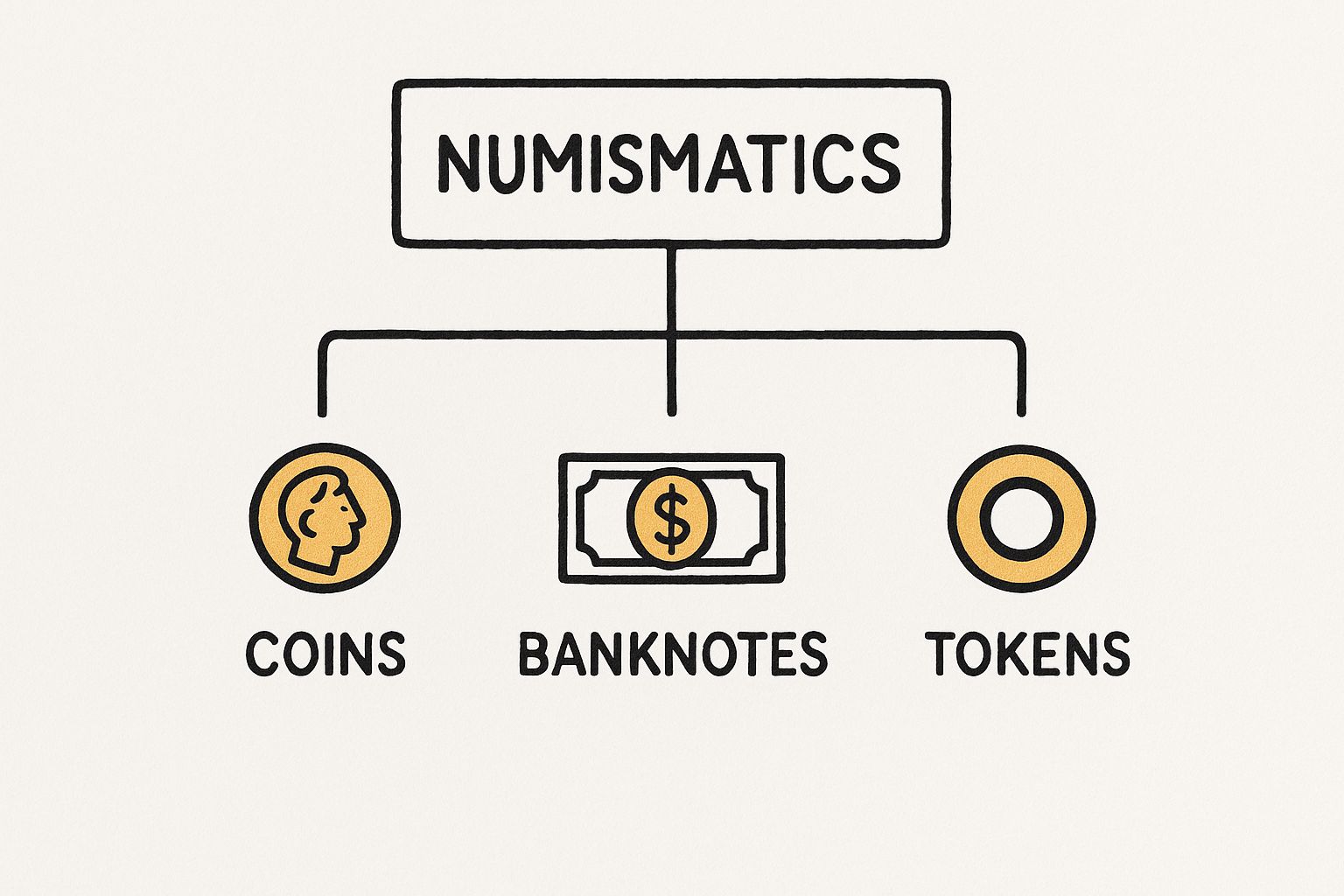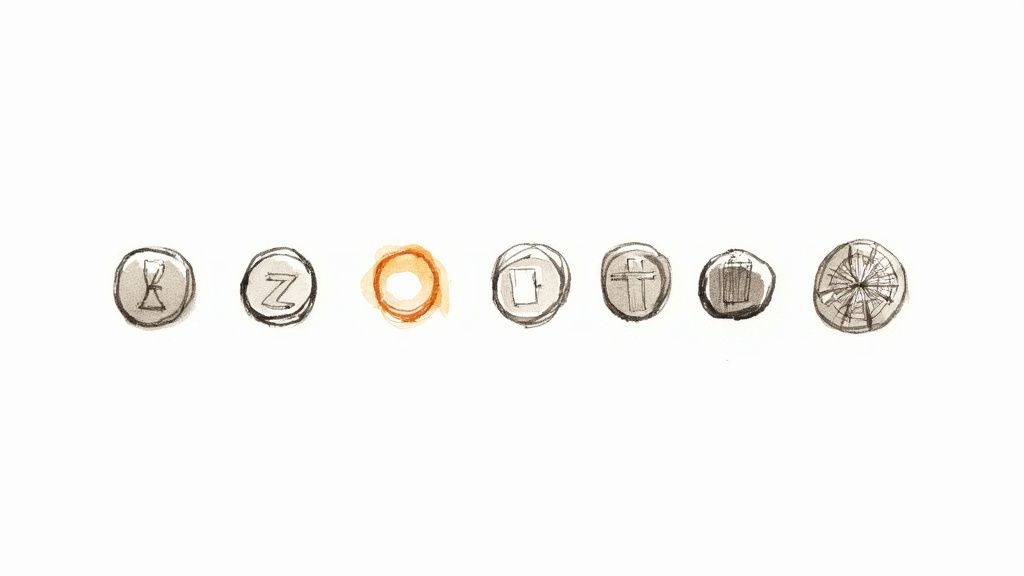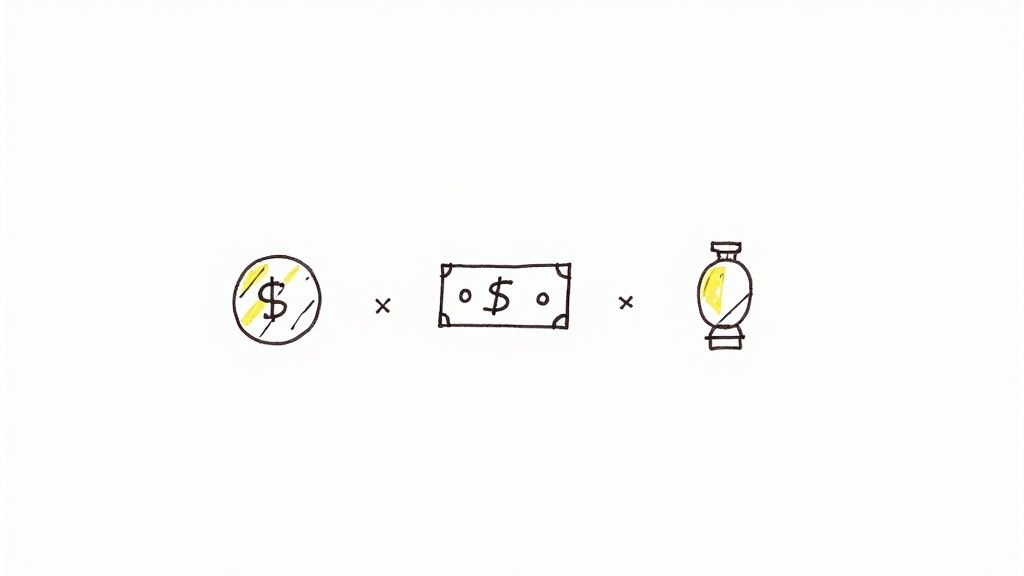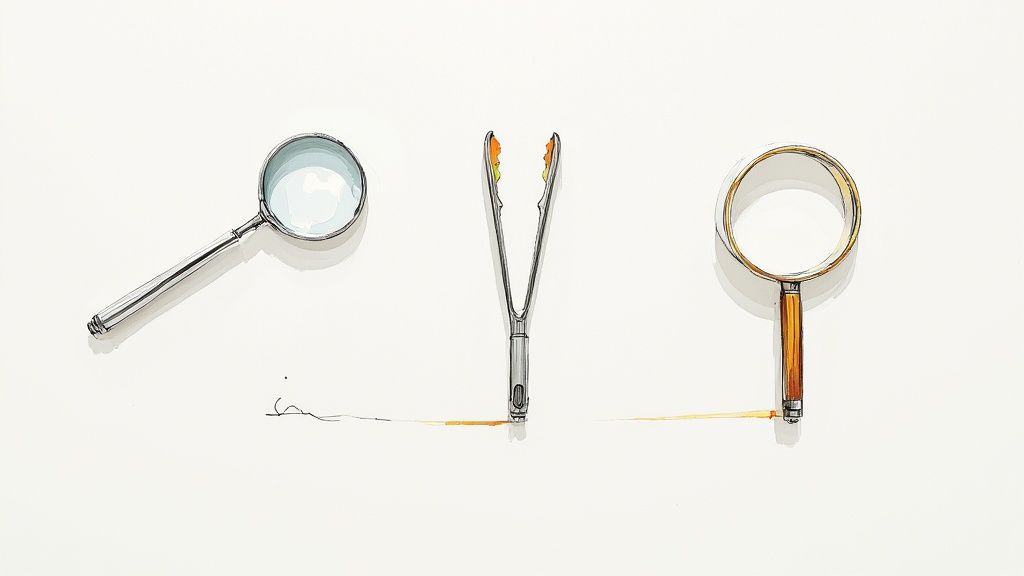If you ask a collector what numismatics is, you’ll get a simple answer: it's the study or collection of currency. That includes coins, banknotes, tokens, and other related bits and pieces. But it’s so much more than just stashing away old pennies in a jar. A true numismatist is part historian, part art critic, and part detective, using these small items to piece together the stories of our past.
Every coin or note you hold is a tangible link to a specific moment in time. It’s a snapshot of history you can actually touch.
Uncovering History Through Currency
At its heart, understanding numismatics means learning to see beyond the face value of a coin or banknote. You start to appreciate these objects as miniature historical documents. They can tell you a surprising amount about the society that created them, from its economic might and political leaders to its artistic tastes and cultural beliefs.
A single, humble coin can whisper tales of epic trade routes, brutal wars, or groundbreaking societal change.
The field is incredibly broad, which can feel a bit daunting at first. But it neatly breaks down into a few fascinating specialisations. These main areas help bring some order to the vast world of currency, allowing collectors and researchers to focus their passion.
The Main Branches of Numismatics
The discipline is generally split into three core areas, each with its own distinct character:
-
Numismatics Proper: This is what most people think of first. It’s the traditional branch, focused purely on the study and collection of coins. This covers an immense timeline, from ancient Greek staters minted thousands of years ago to the modern commemorative coins issued today.
-
Notaphily: This specialisation is all about paper money. Notaphilists dive into the intricate designs, clever security features, and rich historical context of banknotes from all over the world.
-
Exonumia: This fantastic-sounding term covers everything else—all the numismatic items that aren't official coins or banknotes. Think tokens, medals, badges, and even scrip (privately issued money). These pieces often give a wonderfully unique glimpse into local history or specific events that official currency might miss.
To help you visualise how these fields relate to each other, here's a quick look at the main specialisations within the broader study of numismatics.
| Branch | Focus of Study | Examples |
|---|---|---|
| Numismatics Proper | Coins (official government-issued money) | Roman Denarii, British Sovereigns, US Morgan Dollars |
| Notaphily | Banknotes and paper money | Early Bank of England notes, German Papiermark, Chinese "flying money" |
| Exonumia | Tokens, medals, and non-currency items | Transportation tokens, commemorative medals, trade tokens, challenge coins |
This breakdown shows how the study of coins, banknotes, and other items are distinct yet deeply connected fields under the numismatic umbrella.

If you're curious, learning about the origin of the word numismatics can also give you a better feel for its deep historical roots.
Britain's monetary past offers a perfect example of these stories in action. The arrival of Roman coinage after AD 43 completely changed the game, moving society away from simple barter systems. Centuries on, the Great Recoinage of 1816, following the Napoleonic Wars, was another pivotal moment. It standardised British currency, pulled old, worn money from circulation, and brought stability back to the economy. The coins from these periods aren't just metal discs; they are the surviving evidence of these massive historical shifts.
Exploring the Rich History of Numismatics
The fascination with coins is far from a modern hobby. Its prestigious roots stretch back centuries, earning numismatics the grand title of the "Hobby of Kings." This journey really took off during the Renaissance, a period of great intellectual and artistic awakening across Europe.

It was the scholars, popes, and royalty of this era who became the first true collectors. They didn't just see coins as money; they saw them as tangible links to the glories of ancient Greece and Rome. These early numismatists began to methodically organise their collections, laying the groundwork for the academic discipline we recognise today.
From Royal Courts to Public Interest
For centuries, coin collecting was a pursuit largely confined to the wealthy elite who had both the time and the resources to indulge their passion. But the 19th century brought huge social and economic shifts, particularly here in the United Kingdom. As the Industrial Revolution forged a more prosperous middle class, the hobby began to open up to a much wider audience.
This growing public interest led to the creation of formal institutions. The founding of the Royal Numismatic Society in London on December 22, 1836, was a real turning point. It created a formal community for a hobby that was once exclusive, reflecting the era's new wealth and rising educational standards. The society’s growth, which saw its membership nearly double by 1904, shows just how much the appeal of numismatics had broadened. You can explore the full history of the society to see its profound impact on British numismatics.
This evolution transformed numismatics from a private passion into a respected field of study.
Numismatics as a Historical Source
Beyond just collecting, the study of coins became a vital academic tool. When written records are scarce or completely missing, coins can act as primary source documents, offering unparalleled insights into the past.
Rewriting History One Coin at a Time
Today, historians and archaeologists rely heavily on numismatic evidence to fill the gaps in our knowledge. The materials used, the portraits depicted, and even the locations where coins are discovered can help us piece together the past. For instance, they can tell us about:
- Trade Routes: Finding Roman coins in India, for example, provides concrete proof of ancient international trade networks that might otherwise be forgotten.
- Political Events: Sometimes, a coin is the only surviving record of a short-lived ruler or a usurper who tried to seize a throne.
- Cultural Values: The gods, symbols, and mottos featured on coinage reveal what a society held sacred, what they valued, and how they saw themselves.
Each coin is a miniature artefact, a piece of propaganda, and a historical record all rolled into one. The study of what numismatics is, therefore, is really the study of human history itself, captured in metal. A single coin can confirm, challenge, or even completely rewrite a piece of the past we thought we knew.
Learning to Speak the Language of Coins
To really get into numismatics, you have to learn to speak the language. Just like any other hobby, coin collecting has its own jargon. Understanding these terms is what takes you from just looking at a coin to truly appreciating its history, art, and value.

Think of it like learning the basic words of a new language. Once you get the fundamentals down, you can start building sentences and seeing the bigger picture. This knowledge is your key to confidently reading auction catalogues, talking with dealers, and understanding what makes a certain piece so special.
To get you started, we've put together a quick guide to some of the most common terms you'll run into.
Key Numismatic Terms Explained
This table is an essential glossary for any beginner. It breaks down the core terminology used to describe coins and their features. Think of it as your numismatic cheat sheet.
| Term | Simple Definition | Why It Matters |
|---|---|---|
| Obverse | The "heads" side of the coin, usually showing a portrait or the main national symbol. | This is the front of the coin and often helps identify the ruler or country of origin. |
| Reverse | The "tails" side of the coin, which often displays the value or a complementary design. | The reverse design provides extra context, often commemorating an event or displaying a coat of arms. |
| Mint Mark | A small letter or symbol that shows where the coin was made (the mint). | A mint mark can drastically change a coin's rarity and value. Some mints produced far fewer coins. |
| Field | The flat, background area of the coin that doesn't have any design on it. | The condition of the field—whether it's smooth or scratched—is a huge factor in a coin's grade. |
| Legend | The main lettering or inscription on the coin, like the ruler's title or country name. | The legend is the coin's primary text, telling you who issued it, where, and when. |
Learning this vocabulary is your first real step towards analysing a coin like a pro. It lets you describe and identify pieces with the kind of precision that separates a casual collector from a serious numismatist.
Why a Coin's Condition is Everything
Out of all the factors that determine a coin's appeal and price tag, its grade is perhaps the most critical. Grading is simply the professional assessment of a coin's physical condition, rating how much wear and tear it has picked up since the day it was struck.
Think of a coin's grade like the condition of a classic car. An "uncirculated" coin is the equivalent of a car that's been kept in a climate-controlled garage with zero miles on it. A "poor" grade coin is like a trusty old banger that’s been driven hard for decades. Both tell a story, but their value and desirability are worlds apart.
This condition is described using a standard scale, from Poor (heavily worn) right up to Uncirculated or Mint State (a perfect coin with no wear at all). A higher grade nearly always means a higher value.
This is why terms like "lustre" (the original shine from the mint) and "patina" (the surface toning that develops over time) are so important. They are the tell-tale signs of a coin's originality and how well it has been preserved, directly impacting its grade and what numismatics is all about for many collectors—the hunt for quality.
Finding Your Passion in Numismatic Collecting
The world of numismatics is incredibly vast, offering countless paths for a collector to follow. Deciding where to start can feel daunting, but it’s also the most exciting part of the journey. The real key is to find what genuinely sparks your interest, whether that’s the historical weight of ancient coins, the artistic detail of banknotes, or the quirky charm of tokens and medals.

Think of it like choosing a genre for your personal library. Some people are drawn to epic historical sagas, while others prefer modern art books. In the same way, your collection will grow to become a reflection of your own unique passions.
The Classic Appeal of Coins
For many, the heart and soul of numismatics lies in coins. This is the most traditional path, where collectors pursue everything from ancient Greek drachmas and Roman denarii to iconic British sovereigns. The tactile connection to history is a powerful draw—holding a coin that circulated centuries, or even millennia, ago is an experience like no other.
You might choose to focus on a specific:
- Time Period: Such as coins from the Roman Empire or the Viking Age.
- Geographic Region: Focusing on currency from a single country, like Great Britain or Japan.
- Monarch or Ruler: Collecting every coin issued during the reign of Queen Victoria, for example.
- Metal or Denomination: Specialising in silver crowns or copper pennies.
The possibilities are nearly endless, allowing you to create a collection that is deeply personal and endlessly fascinating. Each coin is a miniature artefact, a snapshot of the economy and culture that produced it.
The Artistic World of Banknotes
If intricate design and visual storytelling are what you love, then notaphily—the collection of banknotes—might just be your calling. Paper money offers a much larger canvas for artists. This results in stunningly detailed engravings, vibrant colours, and complex security features that are often works of art in their own right.
A banknote collection can tell the story of a nation's identity, celebrating its heroes, landmarks, and cultural achievements. From the emergency currency printed during wartime to the polymer notes of today, each piece offers a unique perspective on history and technology.
Numismatics Beyond the Obvious
The study of money isn't just about the physical objects you can hold. For instance, medieval numismatics in the UK reveals a fascinating system where physical silver pennies existed alongside abstract accounting units like shillings and pounds. By 1205, the total face value of currency in England was estimated at £250,000, yet much of it was purely conceptual. This really highlights how numismatics helps us understand complex historical economies.
Exploring the Edges with Exonumia
Perhaps your interests lie a bit off the beaten path. If so, welcome to the wonderful world of exonumia. This category covers all the fascinating "money-like" items that aren't official government currency. It’s a field full of personality, niche interests, and unique local stories.
This includes items such as:
- Trade Tokens: Issued by merchants in the 18th and 19th centuries when official small change was scarce.
- Military Medals: Awarded for bravery or service, each one tells a powerful story of individual sacrifice and historical conflict.
- Transportation Tokens: Used for bus or tram fares, these humble pieces evoke a sense of everyday life from a bygone era.
- Commemorative Medallions: Struck to celebrate special events, from royal coronations to world fairs.
Exonumia allows you to connect with history on a very specific, granular level. Whatever path you choose, remember that the goal is to build a collection you truly love. For practical advice on sourcing your first pieces, you may find these seven tips for buying collectable coins useful.
How to Begin Your Coin Collecting Journey
Jumping into the world of numismatics is a genuinely exciting prospect. But where do you even start? The first step isn’t about spending a fortune; it’s about figuring out what truly grabs your attention. The most rewarding collections are always built on passion, so it's worth thinking about what slice of history, art, or geography really fascinates you.
Are you drawn to the might of Roman history, captivated by a particular monarch, or perhaps interested in the incredible wildlife featured on modern coins? Answering questions like these will help you find a theme. This focus not only gives your collection a clear purpose but also makes the hunt for each new piece that much more thrilling. It’s what turns a random pile of metal into a cohesive, personal story.
Essential Tools for Every Collector
Once you have a rough idea of what you want to collect, you’ll need a few basic tools. Don't worry, the initial investment is small, but these items will make a world of difference in how you handle, examine, and preserve your collection.
- A Good Magnifying Glass: A simple magnifier with at least 5x magnification is a game-changer. It will help you see the tiny details, mint marks, and subtle imperfections that make every coin unique.
- Proper Storage: Whatever you do, never store your coins in standard plastic PVC holders or old cardboard boxes. You'll want to invest in acid-free albums, dedicated folders, or inert plastic flips made specifically for coins. This is crucial to prevent long-term damage.
- Cotton Gloves: Your skin has natural oils and dirt that can cause permanent damage to a coin's delicate surface. A simple pair of soft cotton gloves is an absolute must-have for safe handling.
These three simple tools are the foundation of good collecting habits. If you protect your pieces right from the start, you'll ensure they stay in the best possible condition for many years to come.
"The first rule of coin collecting is to do no harm. Your goal is to be a custodian of history, and proper handling and storage are the most important responsibilities a new collector can learn."
Finding Your First Pieces Safely
With your theme chosen and your tools at the ready, it’s time for the fun part: finding your first pieces. It’s tempting to dive straight into online marketplaces, but it’s wise to be cautious to avoid overpaying or, worse, buying fakes. Reputable coin dealers, whether you find them online or at local coin shows, are brilliant resources. They bring expertise to the table and can guarantee the authenticity of everything they sell.
There are so many different ways to get started. For a more detailed walkthrough, our beginners guide on how to start a coin collection offers an excellent roadmap for your first steps. The key is to start small. You can even begin by just looking closely at the change in your pocket to hone your observation skills. This hobby is a marathon, not a sprint, and remember that every great collection begins with a single, fascinating piece.
Got Questions About Numismatics?
As you begin to explore the world of numismatics, it’s only natural for a few questions to pop up. Let's tackle some of the most common ones we hear from people just starting their journey.
Is Coin Collecting an Expensive Hobby?
It certainly can be, but it absolutely doesn't have to be. You can start a truly fascinating collection just by looking through your everyday change, pulling out interesting coins for their face value. Even genuine historical coins, like certain Roman bronze pieces, can be surprisingly affordable.
Ultimately, the cost comes down to what you decide to collect. A set of rare gold sovereigns will naturally be more expensive than one based on modern commemorative 50p coins. The key is to set a budget you're comfortable with and collect what you genuinely enjoy.
How Do I Know if a Coin Is Valuable?
A coin's value really boils down to three main factors:
- Rarity: How many were originally minted, and how many are thought to still be out there?
- Condition: This refers to its state of preservation, which is professionally known as its 'grade'.
- Demand: How many other collectors are actively looking for that exact coin?
Think of it this way: a very common coin in poor shape will have little value beyond its history. But a rare coin in pristine, uncirculated condition can be worth a significant amount of money.
What Is the Biggest Mistake a New Collector Can Make?
Without a doubt, the most common and damaging mistake is cleaning coins. It might feel like a good idea to make an old coin shiny, but doing so almost always destroys its historical and financial value.
Cleaning strips away the coin's original surface and the natural toning, or 'patina,' that has developed over many years. Collectors prize this originality above all else, so it is crucial to leave coins as you find them.
A good rule of thumb is to always handle coins by their edges to avoid fingerprints and store them in proper, non-damaging holders to preserve their condition for years to come.
At Cavalier Coins Ltd, we provide a diverse selection of coins, banknotes, and medals perfect for both new and experienced collectors. Explore our curated collections and find the next piece for your numismatic journey.

